Abstract
Addition of sodium salicylate to human serum at concentrations often obtained during aspirin therapy causes 100-200% increases in free triiodothyronine (T3) and free thyroxine (T4) as estimated by ultrafiltration. The increase in free T3 was unexpected since previous data had suggested that salicylate inhibits binding of T4 only to thyroxine-binding prealbumin (TBPA) and that T3 is not bound to this protein. Using ultrafiltration techniques, we demonstrated binding of T3 to TBPA. The affinity constant for T3-TBPA binding appears to be slightly greater than that for albumin-T3 binding. While salicylate inhibits the binding of T3 (and T4) to TBPA, it can be predicted that little change will be observed in the free T3 (or free T4) without inhibition of thyroid hormone binding to thyroxine-binding globulin (TBG). Using a competitive-binding protein displacement technique, it has been shown that sodium salicylate, like diphenylhydantoin (DPH), inhibits the binding of T3 and T4 to TBG. The magnitude of the increase in free T3 and free T4 induced by salicylates suggests that interference with TBG binding is its major effect.
Aspirin was administered orally to two normal subjects in quantities sufficient to obtain serum salicylate levels of 20-25 mg/100 ml. This resulted in a decrease of 20-30% in total serum T3 and T4 levels. This decrease in T4 levels is similar in magnitude to that previously observed in subjects receiving DPH. Unlike what has been observed with DPH treatment, therapeutic salicylate levels are associated with increases of 50-75% in the unbound fraction of both T3 and T4 which persist throughout an 8-10 day treatment period.
Full text
PDF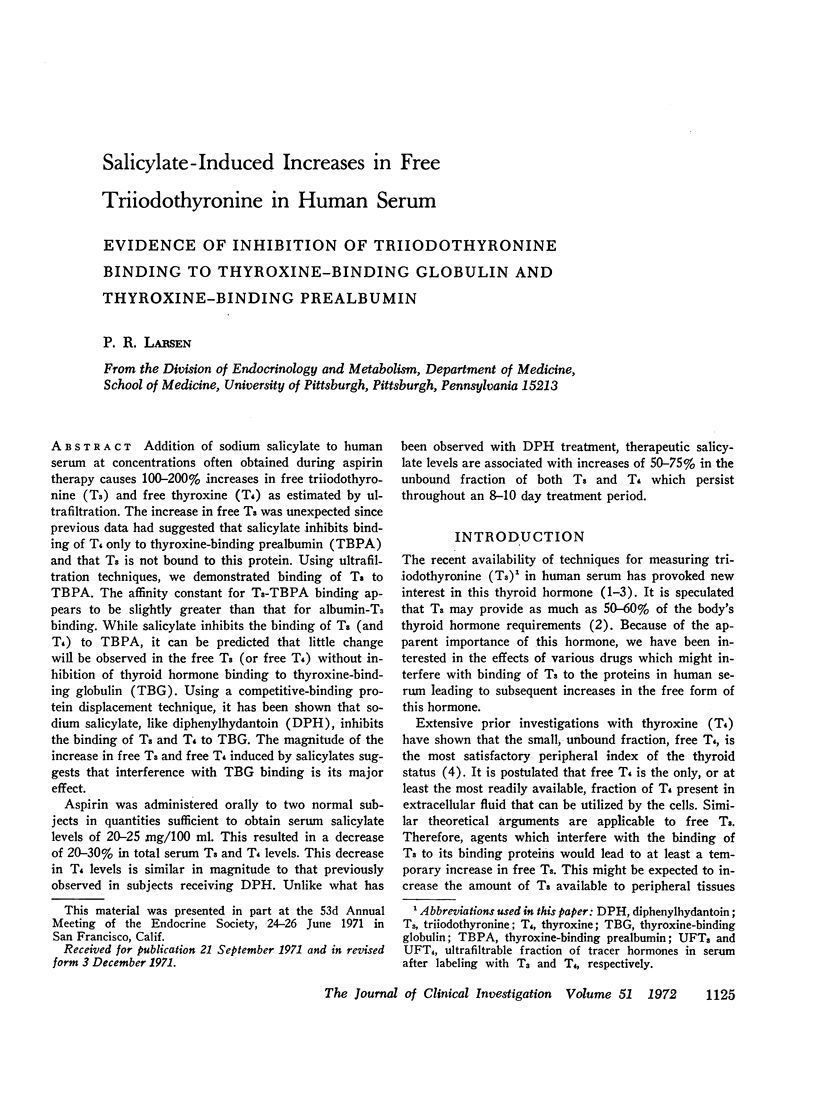
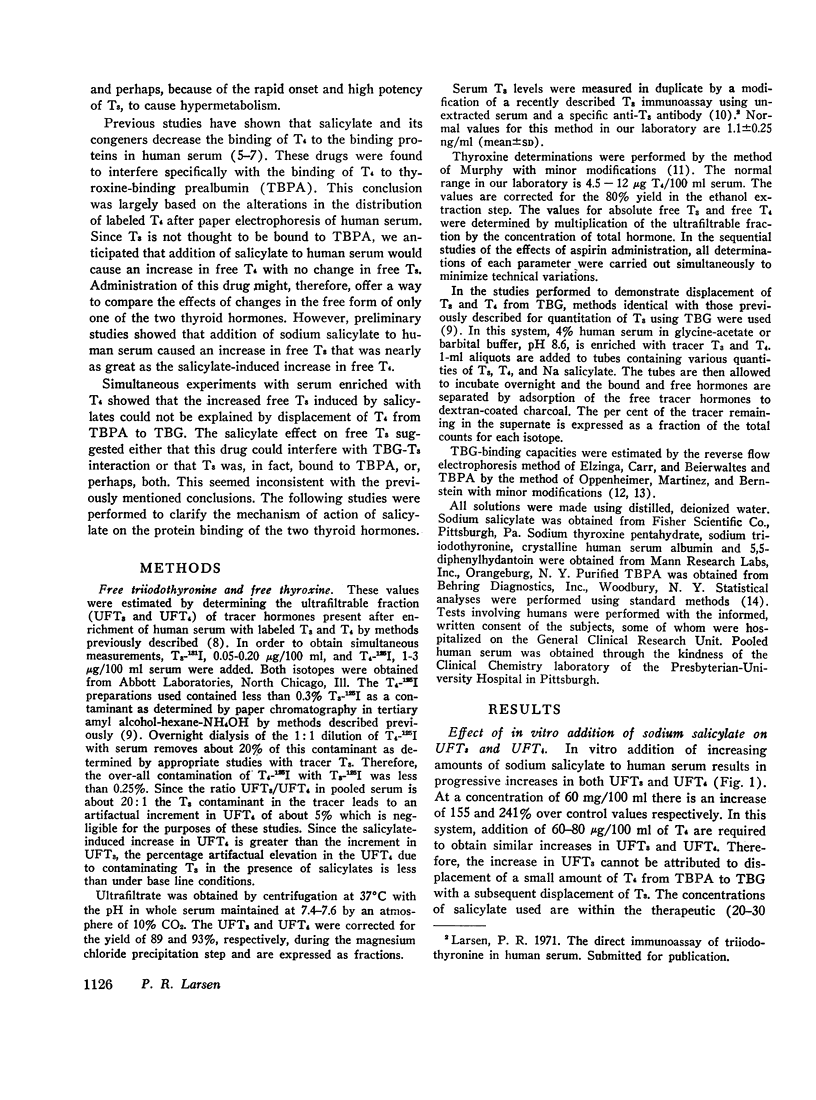


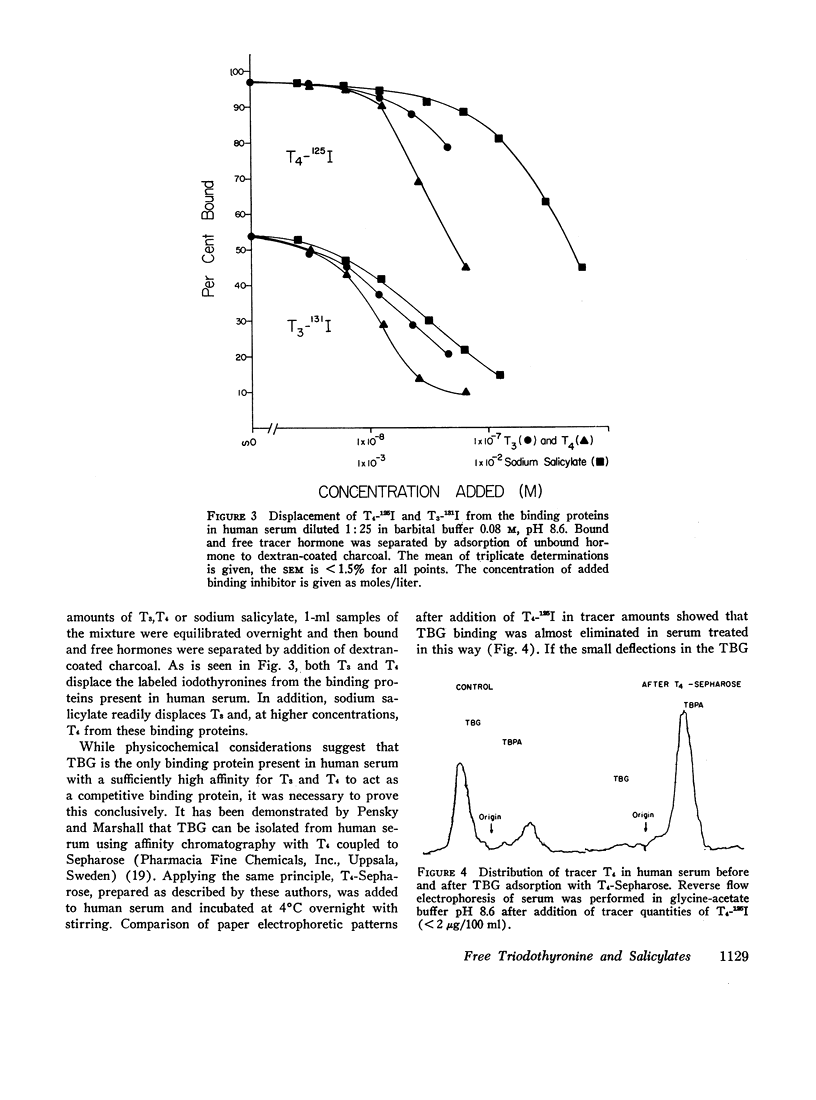

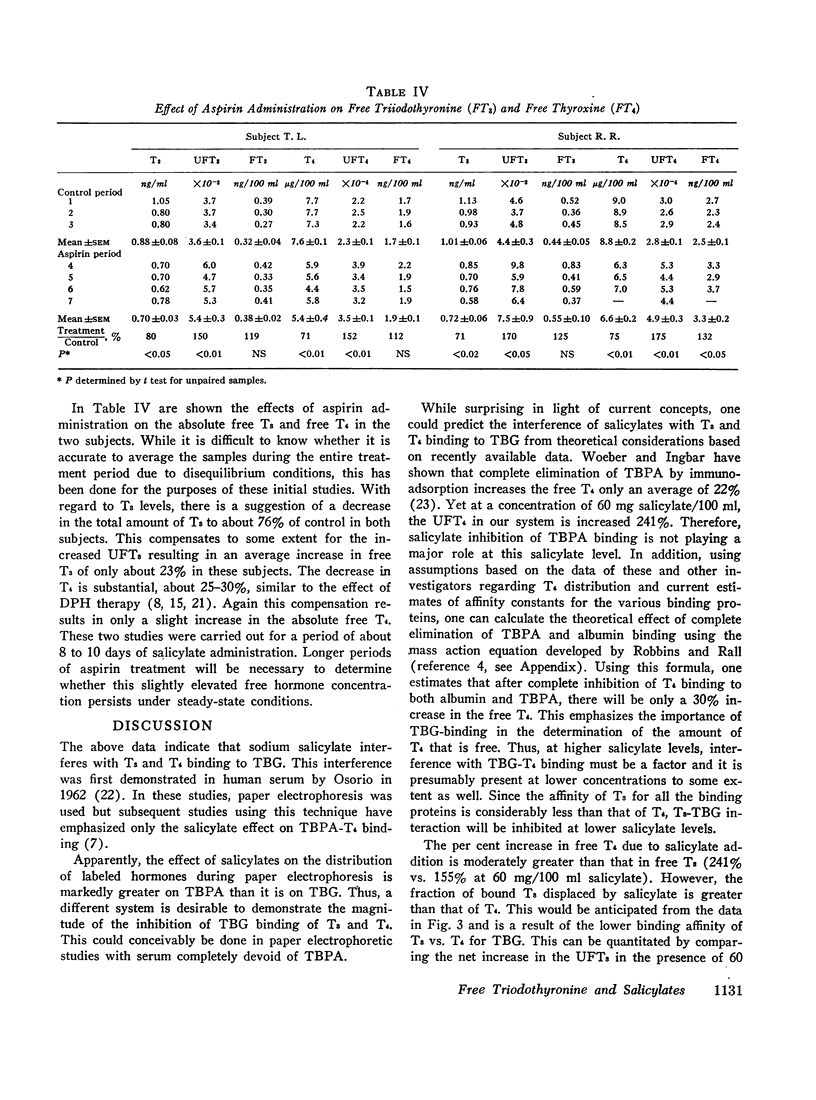
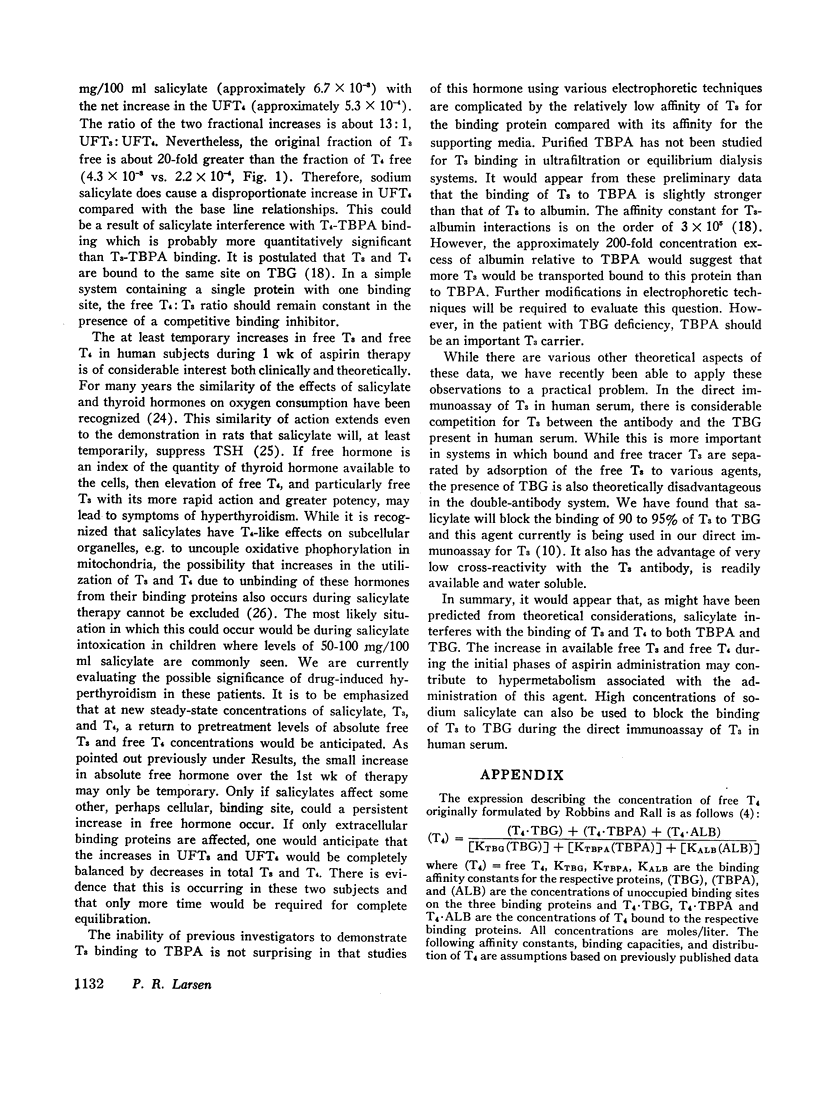

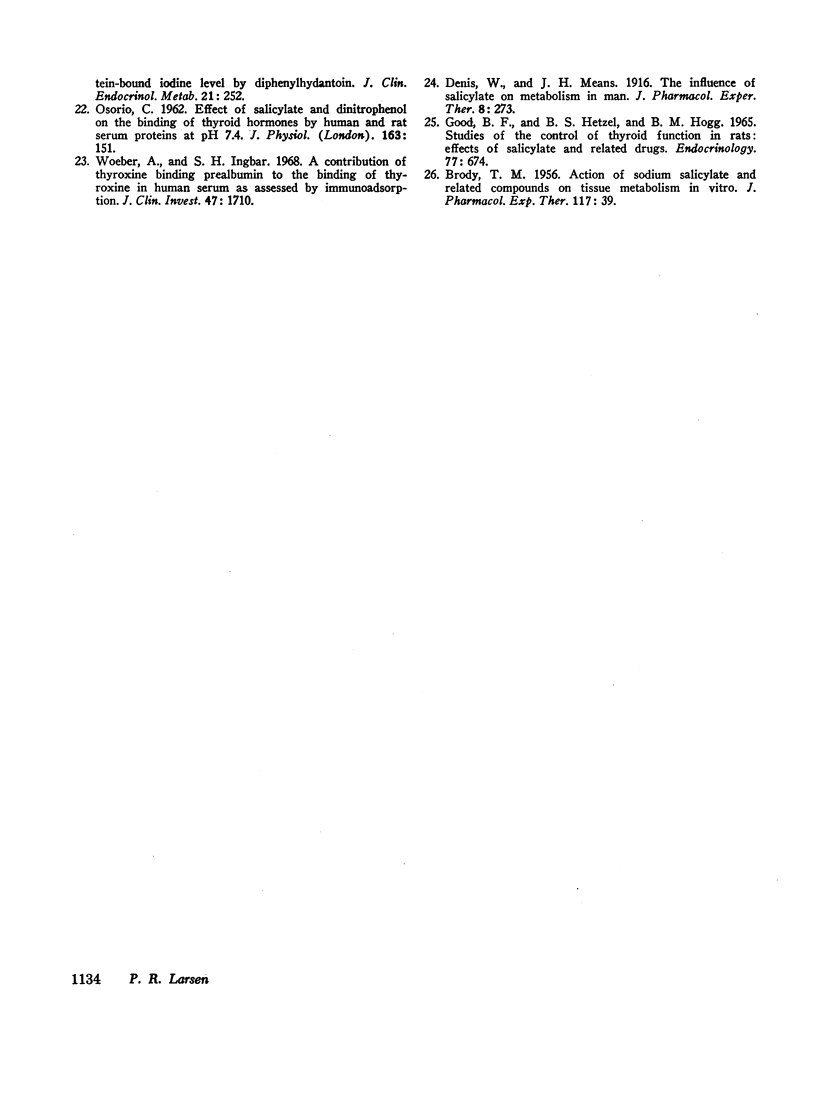
Selected References
These references are in PubMed. This may not be the complete list of references from this article.
- BRODY T. M. Action of sodium salicylate and related compounds on tissue metabolism in vitro. J Pharmacol Exp Ther. 1956 May;117(1):39–51. [PubMed] [Google Scholar]
- CHRISTENSEN L. K. Thyroxine-releasing effect of salicylate and of 2,4-dinitrophenol. Nature. 1959 Apr 25;183(4669):1189–1190. doi: 10.1038/1831189a0. [DOI] [PubMed] [Google Scholar]
- Chin W., Schussler G. C. Decreased serum free thyroxine concentration in patients treated with diphenylhydantoin. J Clin Endocrinol Metab. 1968 Feb;28(2):181–186. doi: 10.1210/jcem-28-2-181. [DOI] [PubMed] [Google Scholar]
- ELZINGA K. E., CARR E. A., Jr, BEIERWALTES W. H. Adaptation of the standard Durrum-type cell for reverse-flow paper electrophoresis. Am J Clin Pathol. 1961 Aug;36:125–131. doi: 10.1093/ajcp/36.2.125. [DOI] [PubMed] [Google Scholar]
- Good B. F., Hetzel B. S., Hogg B. M. Studies of the control of thyroid function in rats: effects of salicylate and related drugs. Endocrinology. 1965 Oct;77(4):674–682. doi: 10.1210/endo-77-4-674. [DOI] [PubMed] [Google Scholar]
- INGBAR S. H. Observations concerning the binding of thyroid hormones by human serum prealbumin. J Clin Invest. 1963 Feb;42:143–160. doi: 10.1172/JCI104701. [DOI] [PMC free article] [PubMed] [Google Scholar]
- Larsen P. R., Atkinson A. J., Jr, Wellman H. N., Goldsmith R. E. The effect of diphenylhydantoin on thyroxine metabolism in man. J Clin Invest. 1970 Jun;49(6):1266–1279. doi: 10.1172/JCI106339. [DOI] [PMC free article] [PubMed] [Google Scholar]
- Larsen P. R. Inhibition of triiodothyronine (T3) binding to thyroxine-binding globulin by sodium salicylate and its application to immunoassay of T3 in human serum. Metabolism. 1971 Oct;20(10):976–980. doi: 10.1016/0026-0495(71)90018-7. [DOI] [PubMed] [Google Scholar]
- Larsen P. R. Technical aspects of the estimation of triiodothyronine in human serum: evidence of conversion of thyroxine to triiodothyronine during assay. Metabolism. 1971 Jun;20(6):609–624. doi: 10.1016/0026-0495(71)90009-6. [DOI] [PubMed] [Google Scholar]
- Mitsuma T., Gershengorn M., Colucci J., Hollander C. S. Radioimmunoassay of triiodothyronine in unextracted human serum. J Clin Endocrinol Metab. 1971 Aug;33(2):364–367. doi: 10.1210/jcem-33-2-364. [DOI] [PubMed] [Google Scholar]
- Nauman J. A., Nauman A., Werner S. C. Total and free triiodothyronine in human serum. J Clin Invest. 1967 Aug;46(8):1346–1355. doi: 10.1172/JCI105627. [DOI] [PMC free article] [PubMed] [Google Scholar]
- OPPENHEIMER J. H., FISHER L. V., NELSON K. M., JAILER J. W. Depression of the serum protein-bound iodine level by diphenylhydantion. J Clin Endocrinol Metab. 1961 Mar;21:252–262. doi: 10.1210/jcem-21-3-252. [DOI] [PubMed] [Google Scholar]
- OPPENHEIMER J. H., SURKS M. I., SMITH J. C., SQUEF R. ISOLATION AND CHARACTERIZATION OF HUMAN THYROXINE-BINDING PREALBUMIN. J Biol Chem. 1965 Jan;240:173–180. [PubMed] [Google Scholar]
- OSORIO C. Effect of salicylate and dinitrophenol on the binding of thyroid hormones by human and rat serum proteins at pH 7.4. J Physiol. 1962 Aug;163:151–159. doi: 10.1113/jphysiol.1962.sp006963. [DOI] [PMC free article] [PubMed] [Google Scholar]
- Oppenheimer J. H., Martinez M., Bernstein G. Determination of the maximal binding capacity and protein concentration of thyroxine-binding prealbumin in human serum. J Lab Clin Med. 1966 Mar;67(3):500–509. [PubMed] [Google Scholar]
- Pensky J., Marshall J. S. Studies on thyroxine-binding globulin (TBG). II. Separation from human serum by affinity chromatography. Arch Biochem Biophys. 1969 Dec;135(1):304–310. doi: 10.1016/0003-9861(69)90544-x. [DOI] [PubMed] [Google Scholar]
- ROBBINS J., RALL J. E. Proteins associated with the thyroid hormones. Physiol Rev. 1960 Jul;40:415–489. doi: 10.1152/physrev.1960.40.3.415. [DOI] [PubMed] [Google Scholar]
- Raz A., Goodman D. S. The interaction of thyroxine with human plasma prealbumin and with the prealbumin-retinol-binding protein complex. J Biol Chem. 1969 Jun 25;244(12):3230–3237. [PubMed] [Google Scholar]
- Sterling K., Bellabarba D., Newman E. S., Brenner M. A. Determination of triiodothyronine concentration in human serum. J Clin Invest. 1969 Jun;48(6):1150–1158. doi: 10.1172/JCI106072. [DOI] [PMC free article] [PubMed] [Google Scholar]
- WOLFF J., STANDAERT M. E., RALL J. E. Thyroxine displacement from serum proteins and depression of serum protein-bound iodine by certain drugs. J Clin Invest. 1961 Aug;40:1373–1379. doi: 10.1172/JCI104368. [DOI] [PMC free article] [PubMed] [Google Scholar]
- Woeber K. A., Ingbar S. H. The contribution of thyroxine-binding prealbumin to the binding of thyroxine in human serum, as assessed by immunoadsorption. J Clin Invest. 1968 Jul;47(7):1710–1721. doi: 10.1172/JCI105861. [DOI] [PMC free article] [PubMed] [Google Scholar]


